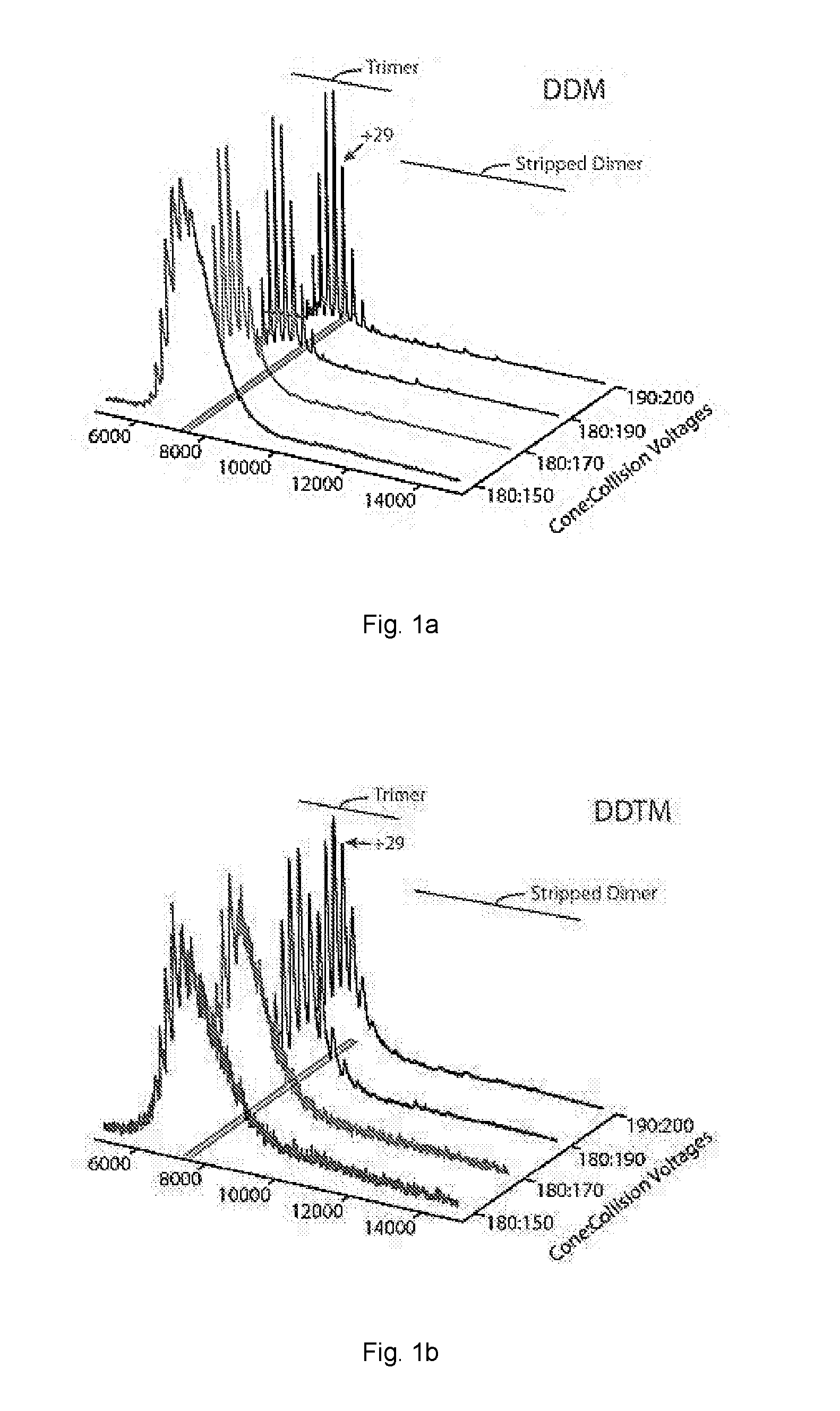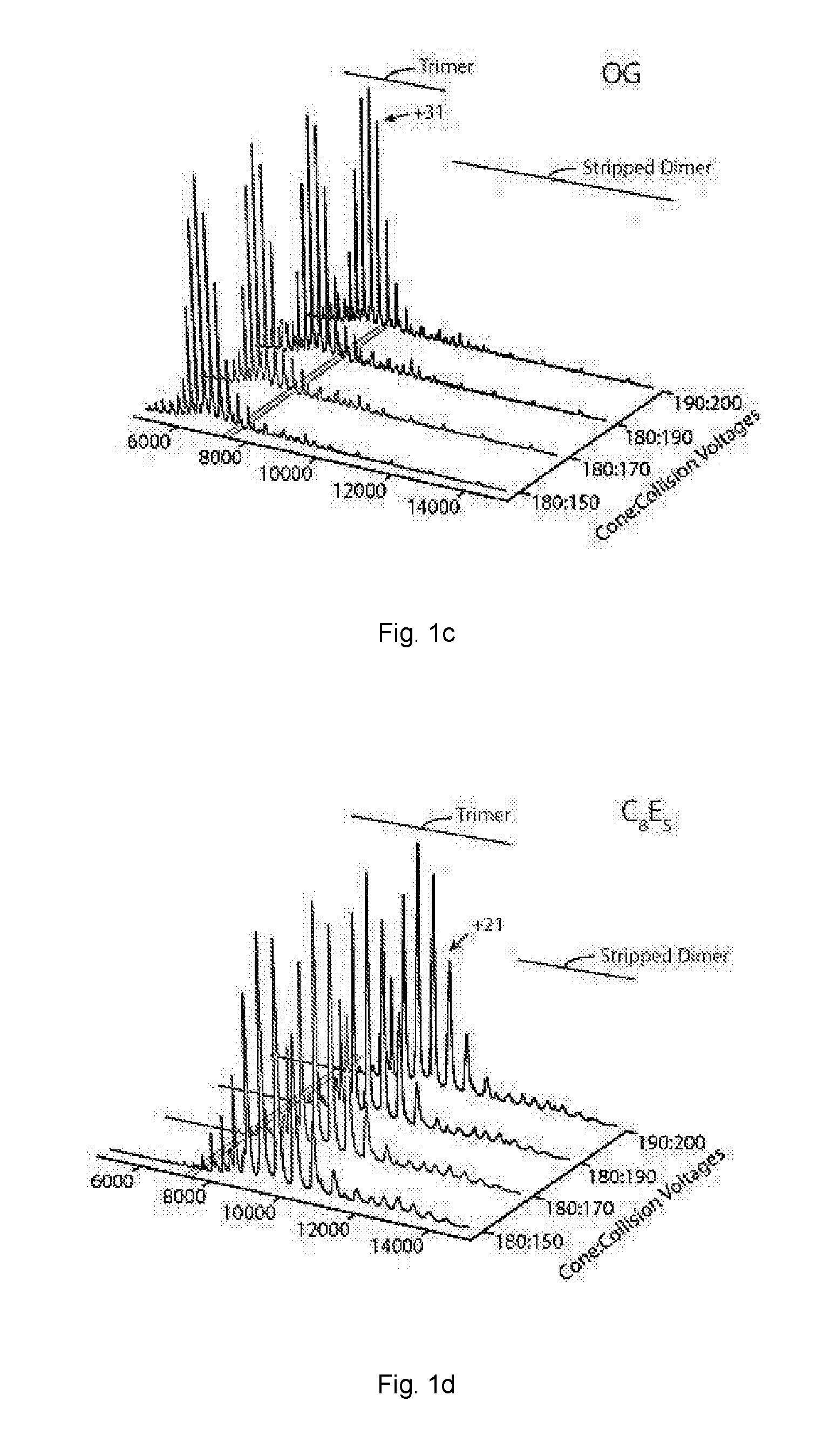Detection of membrane proteins
a membrane protein and detection technology, applied in the field of detection of membrane proteins, can solve the problems of reducing the charge state of membrane proteins, reducing the activation energy needed to liberate membrane proteins from detergent micelles during detection, and reducing the activation energy needed to liberate membrane proteins from detergent micelles
- Summary
- Abstract
- Description
- Claims
- Application Information
AI Technical Summary
Benefits of technology
Problems solved by technology
Method used
Image
Examples
example 1
[0063]The activation energy required to achieve resolved peaks of E. coli ammonium channel C-terminally fused to green fluorescent protein (AmtB-GFP) was assessed for a variety of non-ionic detergents.
[0064]A green fluorescent protein (GFP) expression plasmid was constructed by subcloning the multiple cloning site region from XbaI (New England Biolabs) and BlpI (New England Biolabs) of pET23b (Novagen) into the backbone pET15b (Novagen). The resulting engineered vector was linearized by Ndel (New England Biolabs) and Nhel (New England Biolabs) such that an Infusion cloning reaction (Clonetech) resulted in a TEV cleavable C-terminal fusion to superfolder GFP (subcloned from Gandhi et al., Protein Science 2011, 20, 313-326) followed by a 6× His-tag.
[0065]The AmtB and AQPZ genes were amplified by polymerase chain reaction (PCR) with Phusion high-fidelity DNA polymerase (New England Biolabs) from E coli genomic DNA with primers designed for an Infusion (Clonetech) reaction using the man...
example 2
[0072]Mass spectra activation series for AmtB-GFP and Aquaporin Z (AQPZ) were obtained using a variety of non-ionic detergents.
[0073]AmtB-GFP and AQPZ-GFP were extracted from purified membranes in 2% OG in Buffer B and incubated overnight at 4° C. Extracted membrane proteins were clarified by centrifugation at 20,000 g for 25 minutes at 4° C. The clarified supernatant was filtered before loading onto a 5 mL HisTrap-HP column (GE Healthcare, Piscataway, NJ) equilibrated in Buffer E (200 mM sodium chloride, 10% glycerol, 20 mM Imidazole, 0.025% DDM, and 50 mM TRIS, pH 7.4 at room temperature). After the clarified supernatant was loaded, the column was initially washed with 40-50 mL of Buffer E containing 1% OG instead of DDM followed by several column volumes of Buffer E until a steady baseline was reached. Protein was eluted with a linear gradient to 100% in two column volumes of Buffer F (100 mM sodium chloride, 10% glycerol, 500 mM Imidazole, 0.025% DDM, and 50 mM TRIS, pH 7.4 at r...
example 3
[0080]A mass spectrometry approach was used to monitor the effects of individual lipid binding events on various membrane protein complexes anticipated to respond differently to the phospholipid environment. Three membrane protein complexes were selected to give a range of topologies, oligomeric states and anticipated selectivity towards phospholipids: (i) the pentameric mechanosensitive channel of large conductance (MscL) from Mycobacterium tuberculosis with two transmembrane helices (TMH) and an intimate relationship with phospholipids; (ii) the tetrameric water efflux channel Aquaporin Z (AQPZ) from E. coli with six TMH for which associated phospholipid or detergent molecules have been revealed in crystal structures and in related homologues; and (iii) the trimeric ammonia channel (AmtB) from E. coil, with eleven TMH involved in the transport of ammonia / ammonium, for which no phospholipid binding has previously been observed in crystal structures.
[0081]To study the membrane prote...
PUM
 Login to View More
Login to View More Abstract
Description
Claims
Application Information
 Login to View More
Login to View More - R&D
- Intellectual Property
- Life Sciences
- Materials
- Tech Scout
- Unparalleled Data Quality
- Higher Quality Content
- 60% Fewer Hallucinations
Browse by: Latest US Patents, China's latest patents, Technical Efficacy Thesaurus, Application Domain, Technology Topic, Popular Technical Reports.
© 2025 PatSnap. All rights reserved.Legal|Privacy policy|Modern Slavery Act Transparency Statement|Sitemap|About US| Contact US: help@patsnap.com



